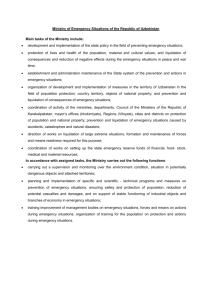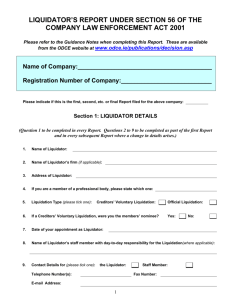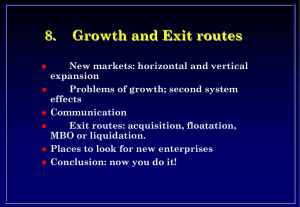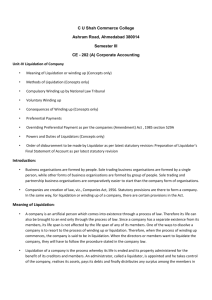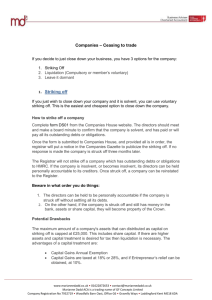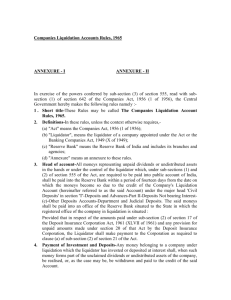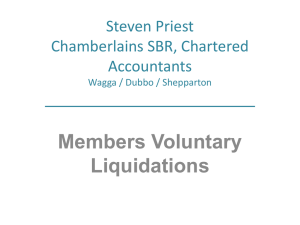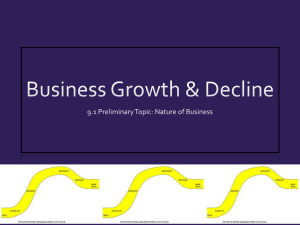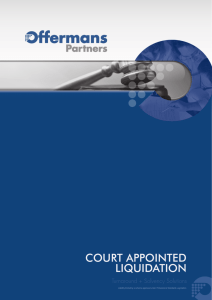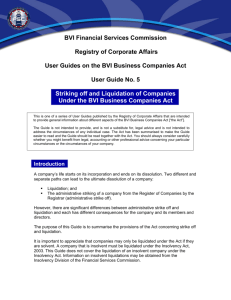Administration and liquidation
advertisement
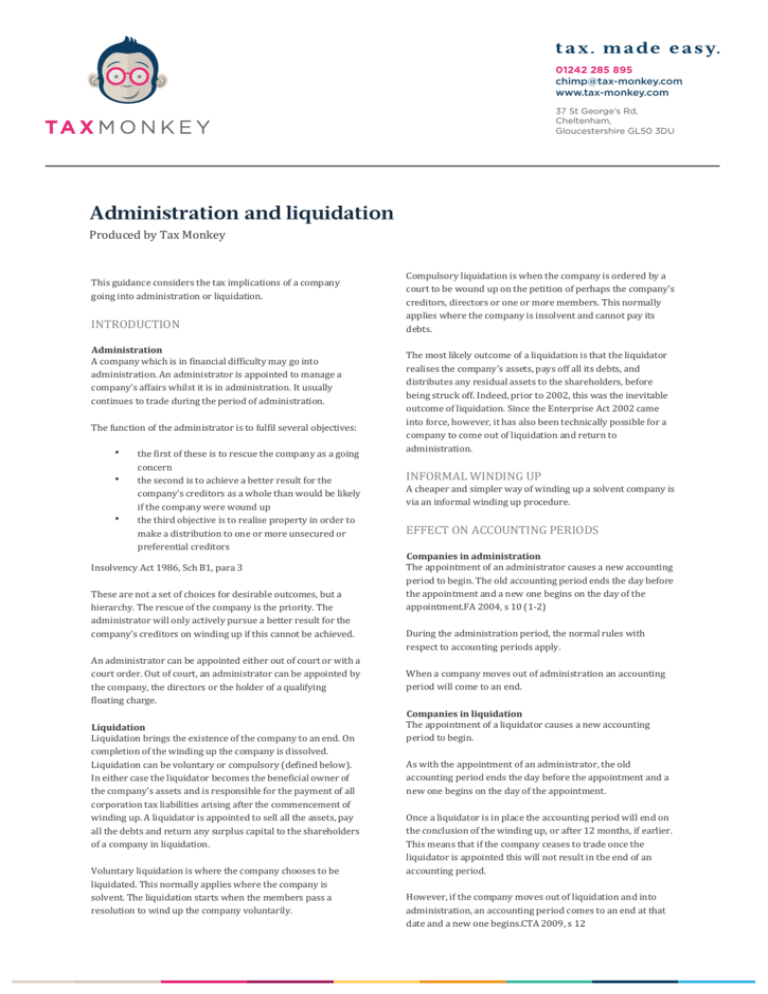
01242 285 895 chimp@tax-monkey.com www.tax-monkey.com 37 St George’s Rd, Cheltenham, Gloucestershire GL50 3DU Administration and liquidation Produced by Tax Monkey This guidance considers the tax implications of a company going into administration or liquidation. INTRODUCTION Administration A company which is in financial difficulty may go into administration. An administrator is appointed to manage a company's affairs whilst it is in administration. It usually continues to trade during the period of administration. The function of the administrator is to fulfil several objectives: • the first of these is to rescue the company as a going concern • the second is to achieve a better result for the company's creditors as a whole than would be likely if the company were wound up • the third objective is to realise property in order to make a distribution to one or more unsecured or preferential creditors Insolvency Act 1986, Sch B1, para 3 These are not a set of choices for desirable outcomes, but a hierarchy. The rescue of the company is the priority. The administrator will only actively pursue a better result for the company's creditors on winding up if this cannot be achieved. An administrator can be appointed either out of court or with a court order. Out of court, an administrator can be appointed by the company, the directors or the holder of a qualifying floating charge. Liquidation Liquidation brings the existence of the company to an end. On completion of the winding up the company is dissolved. Liquidation can be voluntary or compulsory (defined below). In either case the liquidator becomes the beneficial owner of the company's assets and is responsible for the payment of all corporation tax liabilities arising after the commencement of winding up. A liquidator is appointed to sell all the assets, pay all the debts and return any surplus capital to the shareholders of a company in liquidation. Voluntary liquidation is where the company chooses to be liquidated. This normally applies where the company is solvent. The liquidation starts when the members pass a resolution to wind up the company voluntarily. Compulsory liquidation is when the company is ordered by a court to be wound up on the petition of perhaps the company's creditors, directors or one or more members. This normally applies where the company is insolvent and cannot pay its debts. The most likely outcome of a liquidation is that the liquidator realises the company's assets, pays off all its debts, and distributes any residual assets to the shareholders, before being struck off. Indeed, prior to 2002, this was the inevitable outcome of liquidation. Since the Enterprise Act 2002 came into force, however, it has also been technically possible for a company to come out of liquidation and return to administration. INFORMAL WINDING UP A cheaper and simpler way of winding up a solvent company is via an informal winding up procedure. EFFECT ON ACCOUNTING PERIODS Companies in administration The appointment of an administrator causes a new accounting period to begin. The old accounting period ends the day before the appointment and a new one begins on the day of the appointment.FA 2004, s 10 (1-­‐2) During the administration period, the normal rules with respect to accounting periods apply. When a company moves out of administration an accounting period will come to an end. Companies in liquidation The appointment of a liquidator causes a new accounting period to begin. As with the appointment of an administrator, the old accounting period ends the day before the appointment and a new one begins on the day of the appointment. Once a liquidator is in place the accounting period will end on the conclusion of the winding up, or after 12 months, if earlier. This means that if the company ceases to trade once the liquidator is appointed this will not result in the end of an accounting period. However, if the company moves out of liquidation and into administration, an accounting period comes to an end at that date and a new one begins.CTA 2009, s 12 If the company ceases to trade before the liquidator is in place then the normal rules apply and an accounting period will end. CLOSE INVESTMENT HOLDING COMPANY If the company is a close company it may become a close investment holding company (CIHC) when trade ceases. The section relating to CIHC in the legislation has a clause specifically dealing with the position when a company is being wound up. The first accounting period of a winding up will not lead to the company being treated as a CIHC provided that the company was not a CIHC in the accounting period that ends as the winding up starts. In other words, if trade ceases during the first accounting period of liquidation, the company will not be a CIHC until the start of the next accounting period.CTA 2010 s 34(5) The effect of a company being classified as a CIHC is that it will pay corporation tax at the full rate of tax ie the small companies' rate and marginal relief is denied to close investment holding companies. TAX DEDUCTION FOR EXPENSES DURING LIQUIDATION If the liquidator continues to carry on the trade of the company then the normal rules apply. Expenses will be allowable so long as they are incurred wholly and exclusively for the purposes of the trade. The expenses of the liquidator so long as they relate to the trade will be allowable. Those relating to the winding up of the company will not be allowable.CTA 2009, s 189-­‐190 Once the company ceases to trade, it will no longer be able to get a trading deduction for expenses. Post cessation receipts are taxable and post cessation expenses can only be deducted from these post cessation receipts. Thus the cost of collecting debts should be taken into account when valuing assets at cessation and expenses accrued wherever possible.CTA 2009, s 196 At cessation of trade it is likely that the company will have stock. This will be treated as disposed of for market value. Likewise any plant and machinery held at the cessation date will be treated as disposed of for market value.CTA 2009, s 162 REDUNDANCY PAYMENTS Payments to redundant employees are allowed under CTA 2009, s 76. In addition, up to three times the statutory limit are allowed under CTA 2009, s 79 (3). Thus a total deduction of four times the statutory limit is possible. The payments are treated as arising on the last day of the trade.CTA 2009, s 79CTA 2009, s 76 against total profits before charges (terminal loss relief). Therefore it is advantageous for the company to realise chargeable gains prior to trade ceasing as this enables the trading losses to be used against the company's total profits, which include chargeable gains. GROUP RELATIONSHIPS As an alternative to the options above, trading losses may be group relieved to other members of the same group relief group. The impact of the appointment of an administrator / liquidator on group relationships must be considered. Administration A company in administration does not lose beneficial ownership of its assets. However, HMRC's view is that, where the company in administration is a subsidiary of another company, the appointment of an administrator results in arrangements such that the parent no longer controls the company in administration. This is based on the argument that the shareholders can control the parent company but not the subsidiary which is under the control of the administrator. This view may have an impact on the availability of group relief, although it should not have an impact on the capital gains group position. Liquidation Unlike a company in administration, when a liquidator is appointed a company loses beneficial ownership of its assets. However there is express provision that the passing of a resolution or making an order for winding up does not cause the company to cease to be a member of its gains group. Capital gains groups are based on legal ownership of shares rather than beneficial ownership, thus the appointment of a liquidator will not break the gains group.CG40460TCGA 1992 a 170(11) SUBSTANTIAL SHAREHOLDINGS EXEMPTION The substantial shareholdings exemption normally requires the investing company (ie the owner of the shares) to have beneficial ownership of its shares in the investee company. However, where the investing company goes into liquidation, it is still able to benefit from this exemption on a subsequent disposal of any qualifying shares it owns.TCGA 1992, Sch 7AC, Part 2, Para 16 DISTRIBUTIONS UTILISATION OF TAX LOSSES Distributions made during a winding up are capital not income, thus the shareholder is treated as having made a disposal of his shares in return for the amount distributed. If there is more than one distribution in the course of a winding up then each one is treated as a part disposal using the formula A company in liquidation is often a loss making company. When a loss making company ceases to trade, relief is available for these trading losses by: • offsetting the losses against total profits before charges of the loss making period, and then • carrying back three years, on a last in first out basis, . This is an area where planning can be useful. If the company declares a dividend prior to the appointment of the liquidator, the shareholders will be treated as receiving an income distribution (ie a dividend), which may be taxed at the higher or even top dividend rates. If the dividend is paid after the liquidator is appointed it will be a capital distribution. Entrepreneur's relief may be available and the shareholder will be able to use their annual exemption. For an individual to be able to claim entrepreneurs' relief on a disposal of shares the individual must: • have owned at least 5% of the share capital in the trading company, and • been an officer or employee of the company Normally these conditions must be satisfied for at least one year prior to the date of the disposal of the shares. However, for companies in liquidation, the one year period is up to the date that the company ceased to trade. Furthermore, entrepreneurs' relief will only be available if the share disposal takes place within three years of the company ceasing to trade. For a higher rate taxpayer a capital gain would be more tax efficient than a dividend, even if entrepreneur's relief was not available. Corporate shareholders, however, would probably prefer a dividend since companies are not taxed on UK dividends received which are exempt dividends, whereas they are subject to corporation tax on chargeable gains. OTHER TAX IMPLICATIONS OF LIQUIDATION / ADMINISTRATION Corporation tax rates Companies that are in liquidation / administration may make early self assessment returns in order to finalise their affairs based on tax rates applying in the previous tax year. Loan relationships The connected party rules do not apply to companies which have gone into liquidation as they are specifically overridden by the legislation.CTA 2009, s 357 However, this override will only apply while the company remains in liquidation. Where the company comes out of liquidation as a result of these new insolvency provisions, the connected party rules will be reinstated as they were before.
